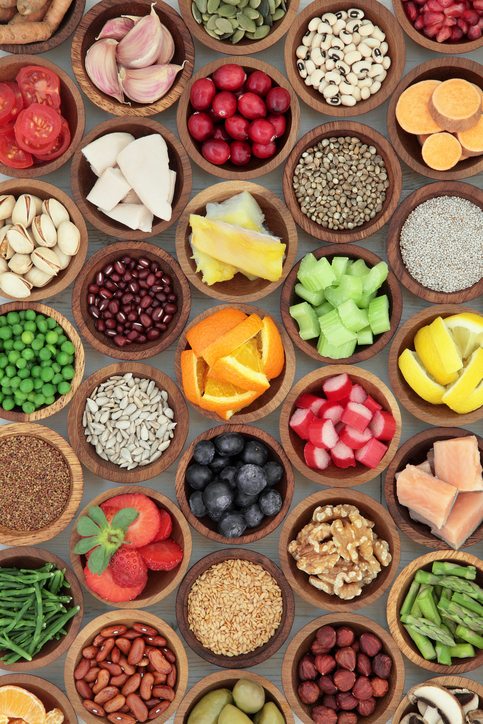
The Healthy Eating Plate can be a great place to start if you are interested in healthy eating. This guide is based on nutritional science and does not involve any commercial pressure. It also explains what foods are healthy and which foods should be avoided, such as too much salt and too much refined sugar. The guide will help you build a solid foundation for your health. Here are some helpful resources.
The MyPlate shows the food groups and teaches consumers how to combine them to create a balanced meal. For example, a nine-inch plate should contain half starchy vegetables, one quarter protein foods and a quarter carbohydrate foods. You can top it off with a zero calorie drink. This is an efficient and simple method for meal planning. This method can be used even by those who aren't so knowledgeable about nutrition and health.

Healthy Eating Plate promotes a wide range fruits and veggies. Americans are notoriously low on vegetable and fruit intake. New guidelines have made a huge impact on our eating habits. The new guidelines encourage people to eat more colorfully and to limit the amount of white potatoes they eat. You will also find a wide range of other foods on this Healthy Eating Plate.
The Food Groups outlined in the MyPlate are the same as those on the MyPlate. These foods are rich in nutrients. These foods are also rich in dietary fiber, so they help us feel full for longer. Whole grains have higher fiber levels, which helps us feel fuller for longer. You can find a lot of information about whole grains and how to choose the best one for you.
The Healthy Eating Plate emphasizes the importance fat. It encourages us to use plant oils in our cooking. These fats help lower harmful cholesterol, which is essential for our health. MyPlate recommends no butter or trans fat. The MyPlate does not recommend a high-carbohydrate diet. This could lead to higher blood cholesterol levels. A healthy diet can improve your health, so make sure to include these foods in your daily routine.

There are many benefits to the Healthy Eating Plate. First of all, it is important to include the right amounts of fats in your diet. The Healthy Eating Plate suggests limiting trans fats and butter, while the MyPlate is silent on fat. This is essential for your heart and weight health. A healthy diet can lower your blood cholesterol levels and improve your health. To get the most nutrients, it is important to eat a wide variety of foods.
FAQ
What is the best way to train?
It all depends what you want. If you want to build muscle mass, then do heavy weights first. Then you can move to cardio. You can then go to strength training if your goal is to lose weight.
Cardio can be done if you want to just lose fat. After that, you can add strength training.
If you are looking for muscle mass, cardio should be your last option. Cardio stimulates growth hormones and helps build muscle mass.
You should also eat before your workout. This will fuel your muscles and make them work harder. You will feel happier during your workout.
How to get rid of belly fat fast
There are several ways to reduce belly fat fast. One way is to eat less food and drink plenty of water.
Another way to increase metabolism is to run and swim.
Sitting down too long is not a good idea if you want your belly to shrink quickly. Stand up often throughout the day. This will help you burn more calories.
There is an alternative option if you've tried all of these options and still have trouble losing belly fat.
This involves using a device called a belt. The belt works by tightening around your waist when you sit down.
As a result, you will feel uncomfortable and move around. This forces you to burn more calories and reduces your belly fat.
Is cardio exercise good for your health or bad?
Cardiovascular exercise offers many benefits. It improves blood flow, strengthens your heart muscle and increases stamina.
Cardiovascular exercise includes running, biking, hiking, swimming, tennis, basketball, soccer, volleyball, football, etc.
It is important to keep in mind that cardio exercises should not only be performed at a high level of intensity, but also at low levels. This could cause injury.
If you feel fine, only do the cardiovascular exercise.
Never push yourself past your limits. You could injure yourself if you do.
Begin by warming up before engaging in cardio exercise. Gradually increase the intensity.
Listen to your body. If you feel pain, stop doing cardio exercise immediately.
Also, after a cardiovascular workout, it's advisable to take a rest. This allows your muscles time to recover.
Cardiovascular exercise can help you lose weight.
This is the best way to lose weight and belly fat.
What is a good gym routine for you?
Regular exercise is key to staying healthy. It doesn't matter which type of fitness you choose, as long as it is done regularly. The most important thing is consistency. To achieve success, you need to persevere for a long time.
Begin by starting to do a little bit of physical activity each day (like walking). Then gradually increase the time spent exercising until you spend 30 minutes a day working out. You could do this by running, swimming, weight training or yoga.
Try to make sure you exercise on all days of the week. Don't miss any sessions unless you have an excuse.
Make sure to wear appropriate clothing and footwear for outdoor exercise. It is important to take into account the weather conditions, and how they may affect your ability to exercise safely.
When you exercise, drink plenty of fluids. Avoid alcohol consumption during this time as it can lead to dehydration. Avoid caffeinated drinks, such as coffee, tea and cola. They may give you energy, but they will also dehydrate you.
You might feel tired when you start to exercise for the first time. Keep going with your workouts and you'll soon feel more energized.
Statistics
- 10 pounds in a month is likely during a lean bulking phase, especially for beginners. (muscleandstrength.com)
- According to the American Heart Association, blood pressure should be checked at least once every two years, beginning at age 20. (my.clevelandclinic.org)
- Get free shipping and 25% off today. (healthline.com)
- Candidates and applicants must pass all four tests at 70% (minimum level) to graduate from Basic Deputy U.S. Marshal (BDUSM) Training. (usmarshals.gov)
- According to the American Academy of Dermatology (AAD), men over 50 are at a heightened risk of developing it. (healthline.com)
External Links
How To
How do I lose weight while working out?
Exercise burns calories by increasing metabolism and oxygen consumption.
At moderate intensity, you will lose weight easily.
To burn fat while exercising, follow these tips:
-
Cardio exercises include swimming, running or cycling.
-
Three times per week, exercise for 30 minutes.
-
If you want to lose more weight, add strength training to your routine.
-
Avoid intense exercise. You can build muscle without breaking down muscle tissue.
-
Keep hydrated during exercise. Water is essential for flushing out toxins and keeping your body hydrated.
-
After exercising, you should drink low-fat protein drinks. Protein shakes can help boost energy and repair muscles.
-
Eat smaller meals throughout the day, so you don't feel hungry between meals.
-
Don't skip breakfast! Skipping breakfast can lead to fatigue and sluggishness.
-
Take care of your mental health. Stressful situations can slow metabolism.
-
Keep a positive attitude. Research shows that overweight people gain more weight if they believe they are overweight than those who believe they look good.
-
Sleep enough. A lack of sleep makes it difficult to lose fat.
-
Stay active. Keep moving every hour.
-
Maintain a healthy diet. You will feel fuller longer if you eat right.
-
Relaxation is possible by finding ways to relax. Tenseness can cause stress hormones to break down muscle tissue.
A balanced diet provides all the nutrients necessary for growth and development.
Six small meals per day is better than three large meals. This gives your body time and energy to process the food.
For strong bones to be maintained, you need approximately 500mg of calcium per day. Calcium can also be found in milk products, yogurt, fortified Soy beverages, orange Juice, cereals and bread.
Calcium can be found in leafy green veggies, beans, tofu and nuts as well as seeds, nuts and cheese.
Vitamin D is required for calcium absorption. Vitamin D is found in certain fortified foods, such as egg yolk and fatty fish.
Vitamin E is crucial for skin health. It's found in vegetable oils, wheat germ oil, peanuts, almonds, sunflower seeds, and corn.
Your body needs zinc to maintain normal immune function and heal wounds. Zinc is found in seafood, oysters legumes meats, whole grains, whole grains and meats.
Zinc deficiency could cause fatigue, nausea, vomiting, and depression.
Too much sugar leads to insulin resistance. This results in higher blood glucose levels. Insulin resistance can lead to weight gain.
When there is a high level of free radicals, insulin resistance can develop. Free radicals are molecules with unpaired electrons that damage cell membranes and other parts of the body.
The main sources of free radicals are food additives.
Free radicals can lead to cancer and heart disease, diabetes mellitus, arthritis, asthma, and premature aging.
Antioxidants are essential for preventing free radical damage. Antioxidants protect against oxidative damage.
Antioxidant vitamins include Vitamin C (found in citrus fruits), beta carotene (found in carrots, sweet potatoes, spinach, broccoli, cantaloupe, apricots, squash, mangoes, peaches, peppers, tomatoes, cabbage, cauliflower, kale, Brussels sprouts, collard greens, watermelon, and strawberries), and Vitamin E (found in nuts, olive oil, avocados, and eggs).
Selenium, manganese (and zinc) are other antioxidant nutrients.
Selenium helps protect cells from oxidative damage caused by free radicals. Selenium can be found in Brazil nuts and liver, kidneys, liver, kidneys, shrimp, cod, turkey and lamb as well as chicken.
Copper protects the brain, eyes, lungs, and red blood cells. Copper is found in shellfishes, poultry, meat, organ meats, and other foods.
Manganese plays an important role in bone structure. Manganese is found as a component of bone structure in brown rice (spinach, bananas), prunes, raisins and oatmeal.
Zinc is required for normal growth, reproduction and wound healing. Zn is found in lean meats, poultry, white fish and eggs.